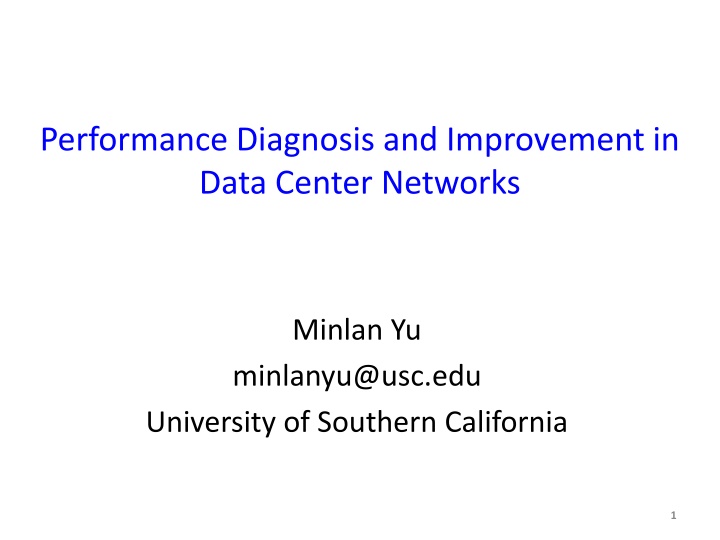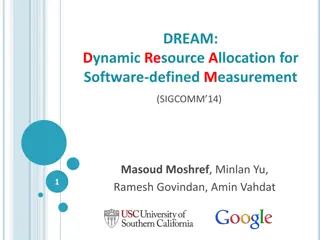
Performance Diagnosis and Improvement in Data Center Networks Overview
Explore key aspects of data center networks, including switches/routers, servers, virtualization, multi-tier applications, virtual switches, top-of-rack architecture, traditional network setups, over-subscription ratios, data center routing, and layer 2 vs. layer 3 considerations for efficient performance diagnosis and improvement.
Download Presentation

Please find below an Image/Link to download the presentation.
The content on the website is provided AS IS for your information and personal use only. It may not be sold, licensed, or shared on other websites without obtaining consent from the author. If you encounter any issues during the download, it is possible that the publisher has removed the file from their server.
You are allowed to download the files provided on this website for personal or commercial use, subject to the condition that they are used lawfully. All files are the property of their respective owners.
The content on the website is provided AS IS for your information and personal use only. It may not be sold, licensed, or shared on other websites without obtaining consent from the author.
E N D
Presentation Transcript
Performance Diagnosis and Improvement in Data Center Networks Minlan Yu minlanyu@usc.edu University of Southern California 1
Data Center Networks Switches/Routers (1K - 10K) . . . . Servers and Virtual Machines (100K 1M) Applications (100 - 1K) 2
Multi-Tier Applications Applications consist of tasks Many separate components Running on different machines Commodity computers Many general-purpose computers Easier scaling Front end Server Aggregator Aggregator Aggregator Aggregator Worker Worker Worker Worker 3
Virtualization Multiple virtual machines on one physical machine Applications run unmodified as on real machine VM can migrate from one computer to another 4
Top-of-Rack Architecture Rack of servers Commodity servers And top-of-rack switch Modular design Preconfigured racks Power, network, and storage cabling Aggregate to the next level 6
Traditional Data Center Network Internet CR CR . . . AR AR AR AR S S . . . S S S S Key CR = Core Router AR = Access Router S = Ethernet Switch A = Rack of app. servers ~ 1,000 servers/pod 7
Over-subscription Ratio CR CR ~ 200:1 AR AR AR AR S S S S ~ 40:1 S S S S . . . S S S S ~ 5:1 8
Data-Center Routing Internet CR CR DC-Layer 3 . . . AR AR AR AR DC-Layer 2 S S S S S S S S . . . S S S S Key CR = Core Router (L3) AR = Access Router (L3) S = Ethernet Switch (L2) A = Rack of app. servers ~ 1,000 servers/pod == IP subnet Connect layer-2 islands by IP routers 9
Layer 2 vs. Layer 3 Ethernet switching (layer 2) Cheaper switch equipment Fixed addresses and auto-configuration Seamless mobility, migration, and failover IP routing (layer 3) Scalability through hierarchical addressing Efficiency through shortest-path routing Multipath routing through equal-cost multipath 10
Recent Data Center Architecture Recent data center network (VL2, FatTree) Full bisectional bandwidth to avoid over-subscirption Network-wide layer 2 semantics Better performance isolation 11
The Rest of the Talk Diagnose performance problems SNAP: scalable network-application profiler Experiences of deploying this tool in a production DC Improve performance in data center networking Achieving low latency for delay-sensitive applications Absorbing high bursts for throughput-oriented traffic 12
Profiling network performance for multi-tier data center applications (Joint work with Albert Greenberg, Dave Maltz, Jennifer Rexford, Lihua Yuan, Srikanth Kandula, Changhoon Kim) 13
Applications inside Data Centers . . . . Front end Server Aggregator Workers 14
Challenges of Datacenter Diagnosis Large complex applications Hundreds of application components Tens of thousands of servers New performance problems Update code to add features or fix bugs Change components while app is still in operation Old performance problems (Human factors) Developers may not understand network well Nagle s algorithm, delayed ACK, etc. 15
Diagnosis in Todays Data Center Packet trace: Filter out trace for long delay req. Too expensive App logs: #Reqs/sec Response time 1% req. >200ms delay Application-specific Host App Packet sniffer OS SNAP: Diagnose net-app interactions Switch logs: #bytes/pkts per minute Too coarse-grained Generic, fine-grained, and lightweight 16
SNAP: A Scalable Net-App Profiler that runs everywhere, all the time 17
SNAP Architecture At each host for every connection Collect data 18
Collect Data in TCP Stack TCP understands net-app interactions Flow control: How much data apps want to read/write Congestion control: Network delay and congestion Collect TCP-level statistics Defined by RFC 4898 Already exists in today s Linux and Windows OSes 19
TCP-level Statistics Cumulative counters Packet loss: #FastRetrans, #Timeout RTT estimation: #SampleRTT, #SumRTT Receiver: RwinLimitTime Calculate the difference between two polls Instantaneous snapshots #Bytes in the send buffer Congestion window size, receiver window size Representative snapshots based on Poisson sampling 20
SNAP Architecture At each host for every connection Collect data Performance Classifier 21
Life of Data Transfer Sender App Application generates the data Send Buffer Copy data to send buffer TCP sends data to the network Network Receiver receives the data and ACK Receiver 22
Taxonomy of Network Performance Sender App No network problem Send Buffer Send buffer not large enough Fast retransmission Timeout Network Not reading fast enough (CPU, disk, etc.) Not ACKing fast enough (Delayed ACK) Receiver 23
Identifying Performance Problems Not any other problems Sender App #bytes in send buffer Send Buffer Sampling #Fast retransmission #Timeout Network Direct measure RwinLimitTime Delayed ACK diff(SumRTT) > diff(SampleRTT)*MaxQueuingDelay Inference Receiver 24
SNAP Architecture Offline, cross-conn diagnosis Online, lightweight processing & diagnosis Management System Topology, routing Conn proc/app At each host for every connection Cross- connection correlation Collect data Performance Classifier Offending app, host, link, or switch 25
SNAP in the Real World Deployed in a production data center 8K machines, 700 applications Ran SNAP for a week, collected terabytes of data Diagnosis results Identified 15 major performance problems 21% applications have network performance problems 26
Characterizing Perf. Limitations #Apps that are limited for > 50% of the time Send Buffer Send buffer not large enough 1 App Fast retransmission Timeout Network 6 Apps Not reading fast enough (CPU, disk, etc.) Not ACKing fast enough (Delayed ACK) 8 Apps 144 Apps Receiver 27
Delayed ACK Problem Delayed ACK affected many delay sensitive apps even #pkts per record 1,000 records/sec odd #pkts per record 5 records/sec Delayed ACK was used to reduce bandwidth usage and server interrupts A B ACK every other packet . Proposed solutions: Delayed ACK should be disabled in data centers 200 ms 28
Send Buffer and Delayed ACK SNAP diagnosis: Delayed ACK and zero-copy send Application buffer Application With Socket Send Buffer 1. Send complete Socket send buffer Receiver Network Stack 2. ACK Application buffer Application Zero-copy send Receiver 2. Send complete Network Stack 1. ACK 29
Problem 2: Timeouts for Low-rate Flows SNAP diagnosis More fast retrans. for high-rate flows (1-10MB/s) More timeouts with low-rate flows (10-100KB/s) Proposed solutions Reduce timeout time in TCP stack New ways to handle packet loss for small flows (Second part of the talk) 30
Problem 3: Congestion Window Allows Sudden Bursts Increase congestion window to reduce delay To send 64 KB data with 1 RTT Developers intentionally keep congestion window large Disable slow start restart in TCP Drops after an idle time Window t 31
Slow Start Restart SNAP diagnosis Significant packet loss Congestion window is too large after an idle period Proposed solutions Change apps to send less data during congestion New design that considers both congestion and delay (Second part of the talk) 32
SNAP Conclusion A simple, efficient way to profile data centers Passively measure real-time network stack information Systematically identify problematic stages Correlate problems across connections Deploying SNAP in production data center Diagnose net-app interactions A quick way to identify them when problems happen 33
Dont Drop, detour!!!! Just-in-time congestion mitigation for Data Centers (Joint work with Kyriakos Zarifis, Rui Miao, Matt Calder, Ethan Katz-Basset, Jitendra Padhye) 34
Virtual Buffer During Congestion Diverse traffic patterns High throughput for long running flows Low latency for client-facing applications Conflicted buffer requirements Large buffer to improve throughput and absorb bursts Shallow buffer to reduce latency How to meet both requirements? During extreme congestion, use nearby buffers Form a large virtual buffer to absorb bursts 35
DIBS: Detour Induced Buffer Sharing When a packet arrives at a switch input port the switch checks if the buffer for the dst port is full If full, select one of other ports to forward the pkt Instead of dropping the packet Other switches then buffer and forward the packet Either back through the original switch Or through an alternative path 36
An Example 37
An Example 38
An Example To reach the destination R, the packet get bounced 8 times back to core Several times within the pod 48
Evaluation with Incast traffic Click Implementation Extend RED to detour instead of dropping (100 LOC) Physical test bed with 5 switches and 6 hosts 5 to 1 incast traffic DIBS: 27ms QCT Close to optimal 25ms NetFPGA implementation 50 LoC, no additional delay 49
DIBS Requirements Congestion is transient and localized Other switches have spare buffers Measurement study shows that 60% of the time, fewer than 10% of links are running hot. Paired with a congestion control scheme To slow down the senders from overloading the network Otherwise, dibs would cause congestion collapse 50

